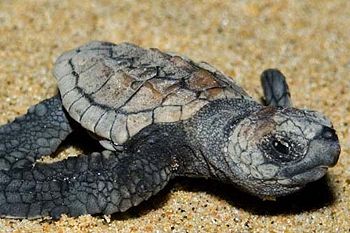Loggerhead sea turtle
| Loggerhead Sea Turtle | ||||||||||||||||
|---|---|---|---|---|---|---|---|---|---|---|---|---|---|---|---|---|
| Scientific classification | ||||||||||||||||
|
The loggerhead sea turtle (Caretta caretta) is an omnivorous, ectothermic, marine reptile that is the most widely distributed of all sea turtle species. Named for its broad head, loggerheads are the largest hard-shelled turtle in the world, weighing 250 pounds and reaching lengths of about 35 inches (the Leatherback turtle is the largest sea turtle, but it’s carapace is covered by skin instead of a hard-shell). Life expectancy in loggerheads is about 50 years, although actual records of age are scarce. The loggerhead sea turtle has a distinct heart-shaped shell that is reddish-brown in color. The turtles’ hard-shell protects them from predators such as sharks. Loggerheads are known to feed on jellyfish, barnacles, shellfish, and occasionally seaweed. Adults can reach speeds of up to 15 miles per hour.
Habitat
Loggerheads spend most of their lives in shallow, coastal waters, and have been found in the Atlantic, Pacific, and Indian Oceans, as well as the Mediterranean Sea. Loggerheads can live in both temperate and warm waters. Habitat preference may change depending on life stage. Hatchlings tend to float in open water, while juveniles prefer to remain in coastal areas.
Nesting Habits
Female loggerheads come ashore during the nesting season, which generally lasts from May to September, but male loggerheads never return to land after birth. Females may nest every year, although most nest every two to three years. Loggerheads migrate long distances to nest at preferred sites, usually areas they return to each time they nest. Each season, a female loggerhead will come ashore an average of four times to nest, laying about 100 eggs in each clutch. Loggerheads seem to prefer nesting above the high tide line and on steeper beaches.[1]
Females emerge from the water to nest at night. Once they find a suitable spot to lay their eggs, the female begins digging a body pit by moving sand with her flippers. Once she is situated, she uses her hind flippers to dig a nest, into which she deposits her eggs. After the eggs are laid, the female will use her hind flippers to fill the nest with sand and then will return to the water. The entire nesting process may take up to three hours.
Hatchling development is dependent on nest temperature. Loggerheads, along with other oceanic turtles, exhibit temperature sensitive sex determination (TSD). The pivotal temperature, the temperature at which a 1:1 ratio of females and males are produced, occurs around 30°C, [2] although this temperature varies depending on location. Females are produced at temperatures above the pivotal temperature, while males are produced at temperatures below the pivotal temperature.
Life Stages
Hatchlings emerge at night after about two months of incubation and use light reflected from the ocean’s surface to guide them to the water. Hatchlings may become disoriented and fail to find the ocean before the sun rises. These hatchlings are likely to be consumed by terrestrial predators or die from the heat of the sun.
Loggerheads that survive typically spend their juvenile years inhabiting warm coastal waters. Not much is known about how maturing loggerheads spend their time, so this period in their life is known as the “lost years.”
Most of loggerheads’ adult lives are spent at foraging grounds [3] where they feed primarily on crustaceans. Loggerhead sea turtles reach sexual maturity between the ages of 12 and 35. Mating generally occurs off the coast of nesting grounds. Males leave this area after mating, while females remain and allow embryos to develop before going ashore to nest.
Threats
On land, incubating clutches are at risk from terrestrial predators who may excavate nests. Hatchling survival rates are low due to threats from predators such as sea gulls flying over beaches and coastal waters. Poaching is still a major threat to the species' existence: loggerhead eggs and hides are rare and thus extremely valuable. Another threat to loggerhead nesting is the building of beachfront property, which limits suitable nesting sites. Artificial lighting is a major deterrent for nesting females and can disorient newborn hatchlings looking for light to guide them to the ocean.
In the water, loggerheads are in danger of getting caught in commercial fishing nets. Offshore oil drilling may result in negative consequences for loggerheads, whose habitat may be altered by the presence of large drilling structures. Garbage and other anthropogenic drifting waste can also harm loggerheads.
Climate change may affect loggerhead survival. Rising sea levels associated with climate change may cause habitat degradation, destroying nesting sites that loggerheads have been using for years. [4] As air temperatures rise, incubating clutches that exhibit TSD may be at risk of becoming predominately female.[5] A predominately female population may lead to decreased reproduction in the species.
Conservation
The United States Fish and Wildlife Service Endangered Species List classifies loggerhead sea turtles as “threatened,” because they are at high risk of becoming endangered and facing extinction in a short amount of time. Conservation efforts include turtle excluder devices (TEDs), which were made to reduce the number of sea turtles becoming entangled in commercial fishing nets. International laws prohibit the trade of the loggerhead products. Because of the loggerhead’s wide distribution, joint conservation efforts of many nations may be necessary to help preserve the species.
References
- ↑ Fish MR, Cote IM, Gill JA, Jones AP, Renshoff S, Watkinson AR. Predicting the impact of sea-level rise on Caribbean sea turtle nesting habitat. Conservation Biology 2005;19(2):482-491.
- ↑ Chaloupka M, Kamezaki N, Limpus C. Is climate change affecting the population dynamics of the endangered Pacific loggerhead sea turtle? Journal of Experimental Marine Biology and Ecology 2008;356(1-2):136-143.
- ↑ Chaloupka et al. 2008 op. cit.
- ↑ Fish et al. 2005 op. cit.
- ↑ Witt MJ, Hawkes LA, Godfrey MH, Godley BJ, Broderick AC. Predicting the impacts of climate change on a globally distributed species: the case of the loggerhead turtle. Journal of Experimental Biology 2010;213(6):901-911.

